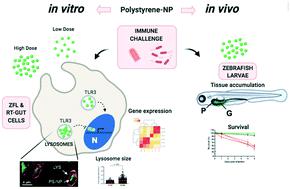当前位置:
X-MOL 学术
›
Environ. Sci.: Nano
›
论文详情
Our official English website, www.x-mol.net, welcomes your feedback! (Note: you will need to create a separate account there.)
Polystyrene nanoplastics accumulate in ZFL cell lysosomes and in zebrafish larvae after acute exposure, inducing a synergistic immune response in vitro without affecting larval survival in vivo
Environmental Science: Nano ( IF 7.3 ) Pub Date : 2020-07-22 , DOI: 10.1039/d0en00553c Irene Brandts 1, 2, 3, 4, 5 , Marlid Garcia-Ordoñez 1, 2, 3, 4, 5 , Lluis Tort 2, 3, 4, 5, 6 , Mariana Teles 1, 2, 3, 4, 5 , Nerea Roher 1, 2, 3, 4, 5
Environmental Science: Nano ( IF 7.3 ) Pub Date : 2020-07-22 , DOI: 10.1039/d0en00553c Irene Brandts 1, 2, 3, 4, 5 , Marlid Garcia-Ordoñez 1, 2, 3, 4, 5 , Lluis Tort 2, 3, 4, 5, 6 , Mariana Teles 1, 2, 3, 4, 5 , Nerea Roher 1, 2, 3, 4, 5
Affiliation

|
The presence of small-sized plastic particles in marine and freshwater environments is a global problem but their long-term impact on ecosystems and human health is still far from being understood. Nanoplastics (<1000 nm) could pose a real and uncontrolled ecological challenge due to their smaller size and sharp ability to penetrate living organisms at any trophic level. Few studies evaluate the impact of nanoplastics in vivo on the immune system of aquatic organisms, while most of them assessed the impact on indirect markers of immune response such as regulation of gene expression, ROS production or DNA genotoxicity, among others. Moreover, the study of the effects of nanoplastics on aquatic vertebrate species in vivo is still scarce. In this context, we seek to shed light on the underlying effects of polystyrene nanoplastics (PS-NPs) on the immune response in a model fish species (Danio rerio, zebrafish) after an acute exposure, with a combination of in vitro and in vivo experiments. Our results show that PS-NPs (65 nm) are efficiently taken up by zebrafish liver cells, accumulating mainly in lysosomes. Furthermore, the expression of immune genes presents a synergy when cells were simultaneously exposed to PS-NPs, at a low dose and early time point (12 h) and challenged with a viral stimulus (poly(I:C)). Moreover, zebrafish larvae also internalize PS-NPs, accumulating them in the gut and pancreas. However, at concentrations of up to 50 mg l−1 in an acute exposure (48 h), PS-NPs do not interfere with the survival of the larvae after a lethal bacterial challenge (Aeromonas hydrophila). This study addresses the relevant environmental question of whether a living organism exposed to PS-NPs can cope with a real immune threat. We show that, although PS-NPs can induce an immune response, the survival of zebrafish larvae challenged with a bacterial infection after an acute exposure to PS-NP is not decimated with respect to unexposed larvae.
中文翻译:

急性暴露后,聚苯乙烯纳米塑料在ZFL细胞溶酶体和斑马鱼幼虫中积累,在体外诱导协同免疫反应,而不会影响体内幼虫存活
海洋和淡水环境中存在小尺寸塑料颗粒是一个全球性问题,但它们对生态系统和人类健康的长期影响仍远未得到了解。纳米塑料(<1000 nm)由于其较小的尺寸和在任何营养水平下都能穿透活生物体的敏锐能力,可能构成一个真正而不受控制的生态挑战。很少有研究评估体内纳米塑料对水生生物免疫系统的影响,而大多数研究则评估对免疫应答间接标记的影响,例如基因表达的调节,ROS产生或DNA遗传毒性等。此外,体内研究纳米塑料对水生脊椎动物的影响仍然稀缺。在这方面,我们寻求对模型中的鱼类的免疫应答聚苯乙烯nanoplastics(PS-NPS)的底层的影响(棚光斑马鱼的急性暴露后,斑马鱼),用的组合在体外和体内实验。我们的结果表明,斑马鱼肝细胞可有效吸收PS-NP(65 nm),主要在溶酶体中积累。此外,当细胞以低剂量和早期时间点(12小时)同时暴露于PS-NP并受到病毒刺激(poly(I:C))攻击时,免疫基因的表达呈现出协同作用。此外,斑马鱼的幼虫也将PS-NP内在化,并在肠道和胰腺中积累。但是,浓度最高为50 mg l -1在急性暴露(48小时)中,PS-NPs在致死性细菌攻击后不干扰幼虫的存活(嗜水气单胞菌)。这项研究解决了有关环境问题,即暴露于PS-NP的活生物体是否可以应对真正的免疫威胁。我们表明,虽然PS-NPs可以诱导免疫反应,但未暴露幼虫的PS-NP急性暴露后,斑马鱼幼虫的存活受到细菌感染的挑战并未减少。
更新日期:2020-08-14
中文翻译:

急性暴露后,聚苯乙烯纳米塑料在ZFL细胞溶酶体和斑马鱼幼虫中积累,在体外诱导协同免疫反应,而不会影响体内幼虫存活
海洋和淡水环境中存在小尺寸塑料颗粒是一个全球性问题,但它们对生态系统和人类健康的长期影响仍远未得到了解。纳米塑料(<1000 nm)由于其较小的尺寸和在任何营养水平下都能穿透活生物体的敏锐能力,可能构成一个真正而不受控制的生态挑战。很少有研究评估体内纳米塑料对水生生物免疫系统的影响,而大多数研究则评估对免疫应答间接标记的影响,例如基因表达的调节,ROS产生或DNA遗传毒性等。此外,体内研究纳米塑料对水生脊椎动物的影响仍然稀缺。在这方面,我们寻求对模型中的鱼类的免疫应答聚苯乙烯nanoplastics(PS-NPS)的底层的影响(棚光斑马鱼的急性暴露后,斑马鱼),用的组合在体外和体内实验。我们的结果表明,斑马鱼肝细胞可有效吸收PS-NP(65 nm),主要在溶酶体中积累。此外,当细胞以低剂量和早期时间点(12小时)同时暴露于PS-NP并受到病毒刺激(poly(I:C))攻击时,免疫基因的表达呈现出协同作用。此外,斑马鱼的幼虫也将PS-NP内在化,并在肠道和胰腺中积累。但是,浓度最高为50 mg l -1在急性暴露(48小时)中,PS-NPs在致死性细菌攻击后不干扰幼虫的存活(嗜水气单胞菌)。这项研究解决了有关环境问题,即暴露于PS-NP的活生物体是否可以应对真正的免疫威胁。我们表明,虽然PS-NPs可以诱导免疫反应,但未暴露幼虫的PS-NP急性暴露后,斑马鱼幼虫的存活受到细菌感染的挑战并未减少。



























 京公网安备 11010802027423号
京公网安备 11010802027423号